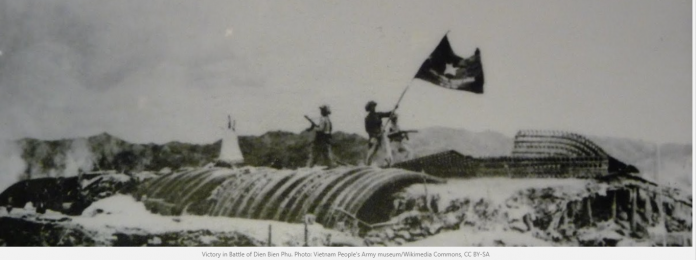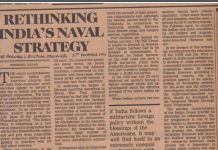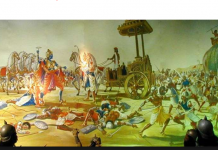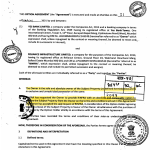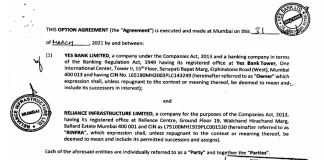Vietnamese ingenuity, in leveraging popular support to liberate their country and abandoning conventional military doctrines, paved the way for a historic victory over French colonialism.

08/MAY/2020
On May 7-8, 1954, a huge garrison of the French Army surrendered to the Vietnamese Peoples’ Army at Dien Bien Phu, a remote mountain valley in north western Vietnam. The surrender ended the French Empire in South East Asia.
How did the Vietnamese army led by Vo Nguyen Giap, an expelled law student who had no formal military training, defeat the vastly better equipped French forces? The answer lies in understanding Vietnamese ingenuity, in leveraging popular support for liberating their country from foreign rule, abandoning conventional western military doctrines for new tactics and modifying military technology to the level of their troops. It is these ingenious adaptations which led to the historic victory of the Vietnamese people over French colonialism.

Victory Tableau at the Dien Bien Phu Museum. Photo: Author provided

Captured US 105 mm Gun at the Vietnam Military History Museum. Photo: Author provided
The French armies greatly outnumbered the Vietnamese regular army – then called “Viet Minh”.
The French had 445,000 soldiers whereas the Viet Minh only had 252,000 soldiers. French strategy was based on fortified “porcupine” bases using their elite paratroopers, armour and mechanised infantry drawn not only from mainland France but also from their colonial possessions in Algeria, Morocco, Senegal, Laos, Cambodia, lowland Vietnam and diverse hill tribes. The French also had the crack troops of the Foreign Legion including German veterans of the SS who applied their brutal experience of European anti-partisan warfare to Indo-China.
Giap used the nationalistic appeal and mass base of the Viet Minh by raising a local militia of two million drawn from the common people who waged a guerrilla war forcing the French to disperse their military all over Indo China in static posts. For Giap, it was essential to disperse the French in different directions so that they could not bring overwhelming force in any one area at one time.
Also read: Ho Chi Minh: Remembering the King and the Saint
In November 1953, the French dropped its elite paratroopers into Dien Bien Phu, (DBP), an air-land-base with two airfields and a series of heavily fortified strong points named Anne-Marie, Beatrice, Dominique, Elaine, Francoise, Gabrielle, Huguette and Isabelle. The powerful French guns were placed in open pits so that they could swivel 360 degrees to cover an attack from any direction. The French hoped to lure the Viet Minh into a definitive battle where they could finally be crushed.
After initial reluctance, the Viet Minh took the bait. The opportunity of turning the tables on the French was irresistible. Giap planned methodically. Firstly, the road route to Hanoi was severed. The French garrison was now totally dependent on aerial supply. Secondly, the French garrison must not be permitted to retreat. Accordingly, the Viet Minh seized nearby Lai Chau, a major gateway to Laos.

Chaffee Tank-Elaine-Hill A-1. Photo: Author provided

Viet 105 mm Gun. Photo: Author provided
Thirdly, the local French collaborators had to be induced to switch their loyalties. More than 25% of the DBP garrison were from the local T’ai ethnic minority. The French helped the White T’ai to monopolise the opium trade from the Hmong opium growers and to take over control of the DBP valley which was traditional Black T’ai territory. The Hmong and the Black T’ai flocked to the Viet Minh. The womenfolk of White T’ai soldiers imprisoned by the Viet Minh promised that if their men were released they would not take up arms again for the French; which promise was kept.
The battle would be decided by logistics. New roads were hacked by hand to enable transport of heavy guns which were dragged and lifted up and down sheer mountainsides and gorges to carefully sited firing points. The main form of transport was the pack-bicycle which could carry more than 250 kilos. Waterfalls were dynamited to enable water transport by rafts which women could steer. Convoys of students, factory workers, peasants, women and ethnic minorities acted as porters carrying food and war stores to the front. The support of this tidal surge of humanity was the greatest strength of the Viet Minh.

Black T’ai Woman. Photo: Author provided
The Viet Minh attack based on “Fast Strike, Fast Victory” scheduled on January 25 1954 was abruptly cancelled by Giap. He realized that his soldiers were not ready. They were night fighters with little experience of day time assaults on fortifications in open terrain. The casualties would be horrendous. Victory uncertain. Instead, a new strategy of siege warfare, “Steady Attack, Steady Advance” was devised, based on new tactics.
Also read: The Story of the Tet Offensive
Giap boldly improvised by positioning his heavy artillery on the inner slopes of the valley well within range of the more powerful French guns. Conventional artillery doctrines of indirect fire were jettisoned. Instead, Giap’s gunners would lay down direct fire over open sights with each gun crew working out its own gun fire coordinates. The Viet Minh built a network of hidden roads, gun tunnels, ammunition depots and quarters for gunners which were so well camouflaged that not a single gun was detected. The valley was a rice bowl with the French at the bottom; the Viet Minh occupied the rim of the bowl and the inner slopes were peppered with their hidden guns.

75 mm Mountain Gun. Photo: Author provided
The Viet Minh used the experience of their Chinese military advisors during the Korean War to construct a vast network of underground tunnels and trenches which enabled attackers to attack fortified French positions under cover. Their trenches encircled the entire French camp and eventually cut through the airfield knocking it out. Giap had innovated a method of warfare which matched the technological level of his troops. The French did not realise that they had lost the option to withdraw.
On March 13, 1954, the Viet Minh artillery opened fire obliterating Beatrice, destroying the command post and the unprotected French guns, killing most of the officers and the gunners, which was then stormed by shock troops who suffered huge casualties but seized Beatrice in barely six hours. The next day, Gabrielle was stormed in identical manner and fell in three and a half hours. Anne-Marie fell without firing a shot as the White T’ai unit deserted en masse. The French artillery colonel was so depressed at his failure to counter Viet Minh artillery that he blew himself up. Huguette fell by trench hidden attackers who shocked the tough Legionnaire defenders into surrendering. Dominique and Francoise also fell after bitter fighting.
Viet Minh artillery had closed the airfield inflicting unacceptable losses on supply aircraft. Trenching tightened the perimeter and cut off French strong points from one another which could no longer be reinforced. Air supply and reinforcements for the French garrison stopped nor could thousands of wounded soldiers be evacuated. Airborne Surgical Teams and paratroopers continued to be dropped along with supplies but more than 30% of the drops landed in Viet Minh hands. Giap’s tactics had successfully drawn the noose tight around the French garrison which was effectively strangled of men and materials.
Bailey Bridge at the Nam Yum river. Photo: Author provided
Also read: In Conversation With Nick Ut, Whose ‘Napalm Girl’ Photograph Changed the Course of Vietnam War
The defenders including French, Algerians, Vietnamese and Legionnaires, mostly paratroopers, fought valiantly, contesting every gun nest and bunker which changed hands several times in ferocious combat. The Viet Minh, having repeatedly failed to take Elaine, named A-1, dug a long tunnel, packed it with explosives and blew it up under the French bunker, but the attackers were mowed down by the surviving paratroopers. However, the end was near.
On May 7, 1954, the French Central Command Post on Elaine headed by General de Castries and his entire staff surrendered. Subsequently, the last French strong point at Isabelle also surrendered. The historic victory of the Vietnamese people at Dien Bien Phu ensured that the sun had finally set on the French Empire in Indochina.
Rabindra Hazari is a Bombay based Advocate and military historian who visited Dien Bien Phu and several military museums in Vietnam.

